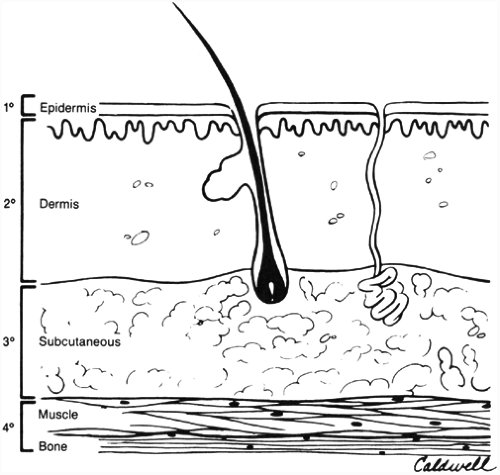Burns
General Information
Thermal burns to the hand occur as a result of energy dissipated from flame, liquid, or gas. Chemical burns arise from direct contact with acidic or extremely alkaline substances. Electrical burns result from the energy dissipated when an electrical current passes through tissue. These injuries commonly occur in occupational situations.
Diagnostic Criteria
It is extremely important to determine the method of burning. The duration of exposure and temperature of the flame should be determined for thermal burns. The nature of the agent must be identified for chemical burns. Current density, duration of contact, the pathway through the body, and the patient’s premorbid medical status should all be identified before treatment is initiated for electrical burns.
Thermal Burns
Burns with skin destruction are referred to as either partial-thickness or full-thickness, depending on the depth of skin and subcutaneous destruction (Fig. 1). Partial-thickness burns may be characterized by erythema, tender skin, or blistering. The skin is red, moist, and blanches with pressure. Burns causing partial-thickness injury are painful. Full-thickness burns may leave the skin dry, hard, white, or even charred. Full-thickness burns destroy the sensory nerve fibers and often are not painful. The size of the injured area of skin should be measured.
Chemical Burns
The skin is often blotchy with blisters in chemical burns. Hydrofluoric acid is a common ingredient in rust removers and is widely used in the glass etching industry. Contact with the skin can cause particularly painful lesions. Sulfuric
acid is found in car batteries and is an occupational hazard for mechanics. Hydrochloric acid is used in toilet and pool-cleaning solvents. Sodium hypochlorite is found in bleach and other household solvents.
acid is found in car batteries and is an occupational hazard for mechanics. Hydrochloric acid is used in toilet and pool-cleaning solvents. Sodium hypochlorite is found in bleach and other household solvents.
 FIG. 1. Skin depth assessment.
Stay updated, free articles. Join our Telegram channel
Full access? Get Clinical Tree
 Get Clinical Tree app for offline access
Get Clinical Tree app for offline access

|



